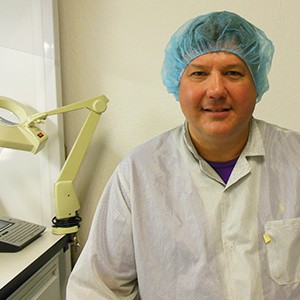
Michael Evans
Michael Evans’ foray into the high-tech and semiconductor field was more by chance than choice. After years of warehouse operations experience in the food industry, he “got a foothold” with Motorola’s supply chain operations.
“From there, I transitioned to production line management and supervision. It was in this field that I truly gained an understanding and appreciation of just how incoming product quality from customer vendors truly plays a huge role in being able to meet final product shipping dates,” said Evans.
Indeed, the oversight of materials, information, and finances as they move from supplier to manufacturer to wholesaler to retailer to consumer is critical to every organization.
While at his next career stop — Hewlett-Packard — Evans’ decision to take the online Supply Chain Management course through San Diego State University’s College of Extended Studies proved even more fortuitous when a kink in the HP supply chain occurred.
Evans shares his experience.
What was the catalyst that prompted you to take the Supply Chain Management course?
I was working at Hewlett-Packard at the time and was in between obtaining my Six Sigma Green Belt and my Black Belt. I saw this course offering by SDSU, and the combination of the price, ease of instruction, what it would accomplish in complementing my belts, and the course content, convinced me that this would be something of significant benefit to me.
There were also some work-related items going on at Hewlett-Packard that prompted me to dive into this course. The fact that a yield excursion event was taking place within the production line at the time, and eventually determined to be supply chain-related, made the timing of my decision optimal. It was coincidental that this excursion occurred pretty much simultaneously with my taking the course, and, coupled with my Six Sigma Green Belt knowledge, helped me to convince management that this issue was supply-chain related, and not process or manufacturing centered.
What is a “yield excursion event”?
We had a precipitous drop in our overall yield rates within a number of manufacturing zones that produced (and supplied) component parts between themselves. In essence, they acted as internal customers to one another, but the common thread was that they all shared the same supply source in that it came externally and at one point of entry. We were receiving HP-manufactured computer die from another plant, and then using these components to assemble and manufacture our product along the line. So when all of a sudden the yields dropped, a task force was created to try and figure it all out. The term used for this in the official paper was “yield excursion task force” and the “event” was the one that was taking place at the present time.
Why did you choose the online Supply Chain Management certificate offered by SDSU?
Convenience was one major factor in that with my busy work schedule, I could go on it when there was a window of time that allowed me to do so. SDSU’s reputation in the work world also played a factor. A certificate from SDSU is recognized and respected within the working world. If you’ve taken courses from this institution, it lends an element of credibility. And third, the staff who worked with me before and after my admission were first-rate in all facets of my time throughout the program. You truly interact with the staff on a personal level, and they truly care that you’re getting something out of the course and program in which you signed up for.
Give us an example of how the Supply Chain Management certificate helped you on the job.
I just recently started a job up in Silicon Valley with a semiconductor-based company. For our new product introduction prototype, engineering was puzzled at trying to contain both a contamination and defect-related issue that seemed to be getting worse as time went on. Usually in a case such as this, either the process that’s developed or how manufacturing carries out the process is the first suspect as to root cause. However, in communicating with operators on the floor who were first-line involved with the manufacturing process, my assumption was that our incoming supply chain was the main cause of our failures.
When a design-of-experiments scenario was devised to test this hypothesis, it showed that this was indeed the case, as our incoming quality screen for materials was not robust enough to handle the spec requirements for this new product introduction. In a situation such as this, my certificate from SDSU helped me to “think outside the box” and consider a wide range of factors as to why our product was not meeting its first-pass yield target, rather than the usual “suspects” that it was either a manufacturing or engineering-related issue.
How long did it take to complete the online SCM program?
I’m a very driven individual so I dove into it and spent roughly 6-7 hours each weekend day for a couple of weekends. I would say roughly about 30 hours in total.
Can you speak to the caliber of the instruction?
The scenarios given of typical Supply Chain Management problems were the most beneficial and helpful while taking the course. These just helped to build on the theoretical aspect of the course material, and lent a “real life” learning experience in order to grasp SCM concepts.
Who do you think could benefit from a course like this?
I think this course would be beneficial for anyone who has done or obtained Lean Manufacturing/Six Sigma project experience or certificates to add this to their résumé. I truly appreciated how this added to my overall base of knowledge in these categories, and consider the importance and impact of supply-chain related items to the overall scope of solving Lean manufacturing or Six Sigma-related issues.
Anything you’d like to add?
For an individual who desires to keep their job skills up-to-date in a competitive business climate, SDSU’s online certificate programs definitely met the criteria of what I needed; and at a tuition price that made it a great value as well.
Supply Chain Management is one of dozens of Professional Development Online Courses in high-demand fields offered through SDSU’s College of Extended Studies. See all the options at NeverStopLearning.net/pdol. If you require a customized program, please email pdol.ces@sdsu.edu or call (619) 594-2517.


